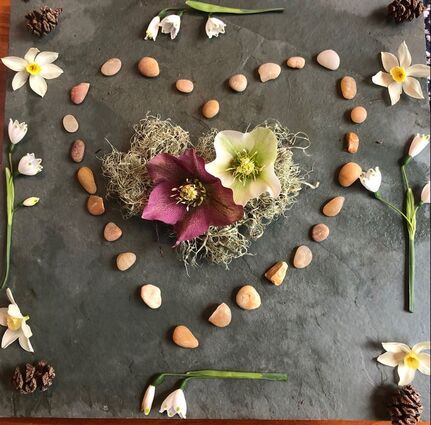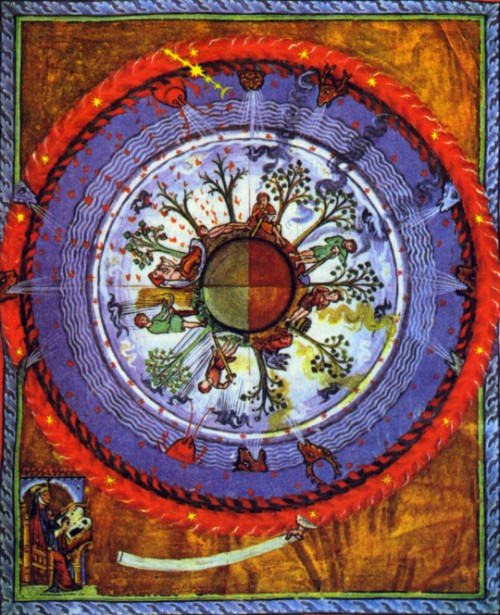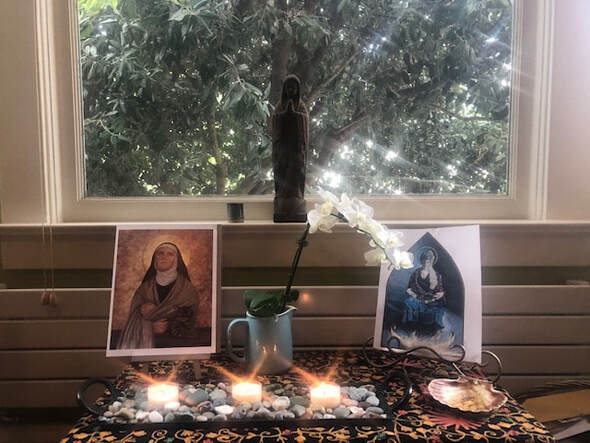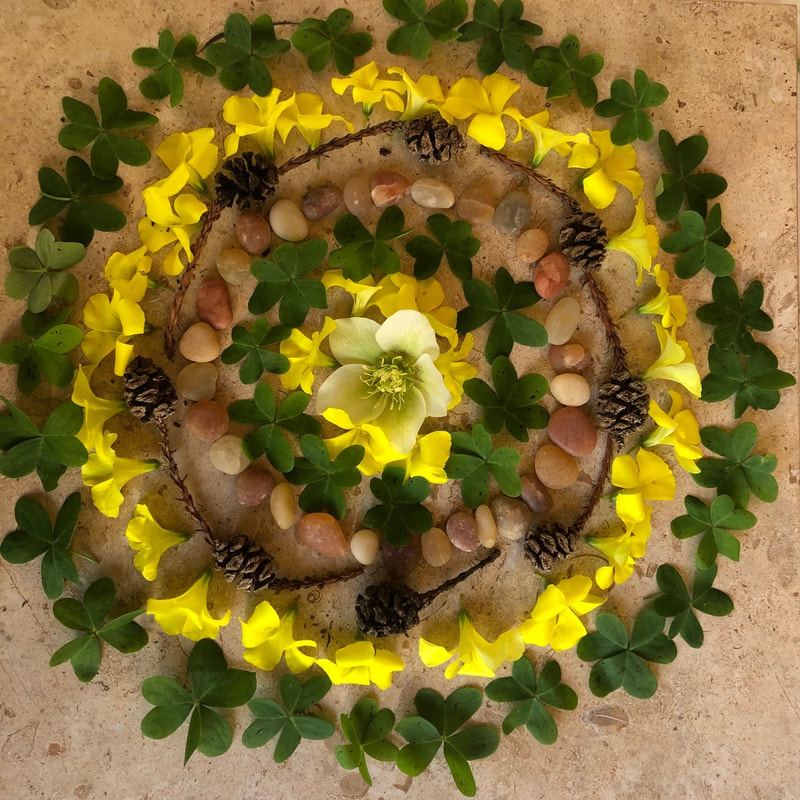Anchored in the Heart
Watch week one here
Week One: Drinking From the Well of Virtue
Much of the idea of monastic spirituality is particularly attentive to establishing a sense of sacred time(kairos) and sacred space (temenos). Both Julian and Hildegard spent over thirty years of their lives enclosed in anchorite cells attached to Benedictine monasteries that were established on top of older sites dedicated to Celtic monastic houses. As such, they inherited the idea that part of spiritual practice consists of tuning oneself to be in harmony with the Earth and its seasons. It is equally important to be in conversation with our spiritual ancestors.
Rhythm of the Heart
The two mottos of Benedictine life are "Ora et Labora" and "Memento mori" . The first means "pray and work" , the twin pillars of this ancient form of spirituality. "Ora" first and foremost was the Divine Office, the eight intervals throughout the day when the chapel bells would ring to call the community to silence and song. The foundation of Benedictine prayer life was the chanting of all 150 psalms over the course of each week. The psalms are the very words that Jesus himself knew by heart ( his last words on the cross were quoting Psalm 22). These form the basis for the vast and magnificent repertoire of what we call Gregorian or Benedictine chant- a topic we will explore in depth in week 4.
Much of the idea of monastic spirituality is particularly attentive to establishing a sense of sacred time(kairos) and sacred space (temenos). Both Julian and Hildegard spent over thirty years of their lives enclosed in anchorite cells attached to Benedictine monasteries that were established on top of older sites dedicated to Celtic monastic houses. As such, they inherited the idea that part of spiritual practice consists of tuning oneself to be in harmony with the Earth and its seasons. It is equally important to be in conversation with our spiritual ancestors.
Rhythm of the Heart
The two mottos of Benedictine life are "Ora et Labora" and "Memento mori" . The first means "pray and work" , the twin pillars of this ancient form of spirituality. "Ora" first and foremost was the Divine Office, the eight intervals throughout the day when the chapel bells would ring to call the community to silence and song. The foundation of Benedictine prayer life was the chanting of all 150 psalms over the course of each week. The psalms are the very words that Jesus himself knew by heart ( his last words on the cross were quoting Psalm 22). These form the basis for the vast and magnificent repertoire of what we call Gregorian or Benedictine chant- a topic we will explore in depth in week 4.
Portable altars made of boxes (as small as breath mints!0 by Lynn Karegeannes
Creating an Altar
As we begin this class, I encourage you to dedicate a place for the Lenten exploration you will do. If you can dedicate a room for this exploration, wonderful, If not, a corner of a room will do. If not a corner, then a table.
If not a table,even a small portable cardboard box that can be a "moveable altar" or retablos will help give you a focus for contemplation. In the Celtic tradition, we can tune ourselves to the cosmos by seeking wholeness and fulfillment rather than "perfection". To that end, finding our place in the larger natural world is deeply grounding and healing. Hildegard stresses that the Symphony of Creation consists of the harmony of all natural things.
To that end, consider how you might create an altar that includes elements of air, earth, fire, and water.
Creating an Altar
As we begin this class, I encourage you to dedicate a place for the Lenten exploration you will do. If you can dedicate a room for this exploration, wonderful, If not, a corner of a room will do. If not a corner, then a table.
If not a table,even a small portable cardboard box that can be a "moveable altar" or retablos will help give you a focus for contemplation. In the Celtic tradition, we can tune ourselves to the cosmos by seeking wholeness and fulfillment rather than "perfection". To that end, finding our place in the larger natural world is deeply grounding and healing. Hildegard stresses that the Symphony of Creation consists of the harmony of all natural things.
To that end, consider how you might create an altar that includes elements of air, earth, fire, and water.
We will also consider the importance of the veneration of the ancestors- both physical and spiritual. For Hildegard, these consisted of the religious figures of her tradition, with particular attention to the "local saints" of her community at Rupertsburg. Who are your "saints"? Consider putting objects that belonged to them or pictures of them on your altar and rotating these with the seasons In my studio, I currently have icons of Hildegard and Julian, with rocks gathered from Iona and La Baume; candles blessed from Chartres, a scallop shell from the Camino Santiago Compostela, new blossoms from my garden.
I actually have different "altars" in every room of my house. I have a "family altar" of photos of my grandparents, a statue sculpted by my father, my daughter's small dolls and books written by my aunt and mother. On top of my piano are books of Bach and Beethoven and pictures of my former piano students. . You might consider how can you make an "anchor" in every room of the house that evokes your connection to the spirit of things that matter most to you and remind you of who you are and where you came from. Even if space is limited,
Both Hildegard of Bingen and John Cassian stressed the importance of cultivating the virtues and placing before us examples of those who "flowered" in a particular quality. We will be exploring the virtues of Hope, Discernment/Discretion, Compassion, Generosity, Mercy and Humility as we journey together as these are virtues both saints felt were deeply important in the spiritual life-- and they are qualities we are very much in need of in our world right now.
Modern psychological research has revealed that one of the most important antidotes for depression in the practice of gratitude. Consider adopting as a spiritual practice for Lent the creation of a Gratitude Journal. At the end of each day, reflect on what you have seen, heard, shared or experienced that touched you. This is a practice which can grow easier with practice, as you tune yourself to pay deeper attention to the sunrise, the new buds and blossoms, and seek out the "Good, the True and the Beautiful". If you are living with others, you might a consider turning your conversation at dinner to this topic. Where did you see or hear of a story of goodness in the world?
Questions for Journaling and Discussion:
Which virtues would you most like to cultivate in yourself? In the world?
Who are the people (in your life, in history, in fiction) who exemplify these qualities?
Consider making a "soul collage" of one of these virtues each week in your Gratitude Book
Modern psychological research has revealed that one of the most important antidotes for depression in the practice of gratitude. Consider adopting as a spiritual practice for Lent the creation of a Gratitude Journal. At the end of each day, reflect on what you have seen, heard, shared or experienced that touched you. This is a practice which can grow easier with practice, as you tune yourself to pay deeper attention to the sunrise, the new buds and blossoms, and seek out the "Good, the True and the Beautiful". If you are living with others, you might a consider turning your conversation at dinner to this topic. Where did you see or hear of a story of goodness in the world?
Questions for Journaling and Discussion:
Which virtues would you most like to cultivate in yourself? In the world?
Who are the people (in your life, in history, in fiction) who exemplify these qualities?
Consider making a "soul collage" of one of these virtues each week in your Gratitude Book
Gratitude Mandala dedicated to Rosemerry Wahtola Trommer
Song of the Week: O Virtus Sapientia
O Power of Wisdom
who encloses all
in one lifegiving, circular path,
three wings you have:
one soars to the heights of Heaven
one reaches down to touch the essence of earth,
and the third flies everywhere, encircling us all.
Praise to you, as is most fitting
O Strength of Wisdom
Text by Hildegard von Bingen, translated Kayleen Asbo
sung by Karen Clark
Song of the Week: O Virtus Sapientia
O Power of Wisdom
who encloses all
in one lifegiving, circular path,
three wings you have:
one soars to the heights of Heaven
one reaches down to touch the essence of earth,
and the third flies everywhere, encircling us all.
Praise to you, as is most fitting
O Strength of Wisdom
Text by Hildegard von Bingen, translated Kayleen Asbo
sung by Karen Clark
Recommended Sources for Readings and Reflections for Our Journey to. Come:
Julian's Gospel: Illuminating the Life and Revelations of Julian of Norwich, Veronica Mary Rolf is an excellent resource for historical information about the first woman to write in the English langauge and her times.
Hildegard of Bingen: A Spiritual Reader, Carmen Acevedo Butcher is one of the most accessible collections of Hildegard's writings.
Julian of Norwich: Revelations of Divine Love, translation by Mirabai Starr is the preferred edition and translation of many modern readers who are searching for a more contemporary and universal language.
Rule of St. Benedict: A Spirituality for the 21st Century, Joan Chittester. Written by a Benedictine nun deeply committed to social justice, this translation and commentary encompasses a cross cultural scope while being firmly rooted in the monastic tradition.
Celtic Benediction, John Philip Newell. A beautiful resource of morning and evening prayers to create "book ends' of your days using language that is widely accessible and encompassing, friendly even to most church- wounded. Each day's prayers takes only about 10 minutes to read, making it ideal for people who fear they do not have time to keep the "divine office".
Christine Valters Paintner is a wonderful contemplative writer and teacher whose many books weave together a reverence for tradition with modern practice. Her Abbey of the Arts is the place to begin. I've just ordered my own copy of her latest book, Sacred Time, and anticipate a rich treasure ahead!
For those who are interested in diving deeply into the early Christian Tradition, John Cassian's Conferences ( part of the Classics of Western Spirituality Series) is an excellent source. For a very friendly introduction and modern perspective on Cassian's work, you could check out the essays by Justin Coutts published in New Eden Ministry and join the online facebook group The Virtual Chapel.
For Poetry Practice, here are my two favorite resources for poet who bring us back to the beauty of nature and remind us again and again of beauty, generosity and gratitude:
Rosemerry Wahtola Trommer, you can sign up for her daily poem here as well as search the site for particular themes like "hope" and "gratitude".
Mary Oliver, Devotions
Brother David Standl- Rast's organization gratefulness.org is a wonderful resource for inspiring stories
Contact Kayleen Asbo: [email protected]




